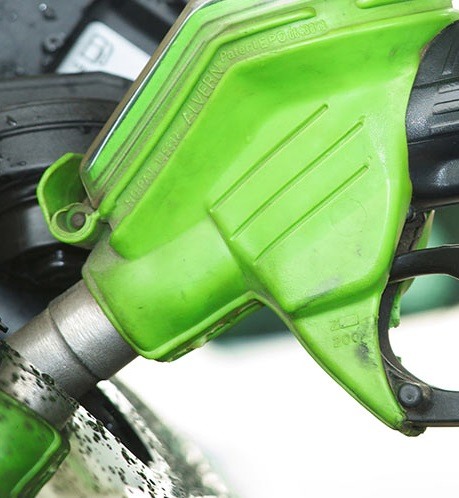How can more environmentally-friendly fuels be produced for cars, trucks, planes and boats? The answer lies in advanced biofuels and e-fuels! Produced from plant residues, organic waste, renewable electricity associated with CO2 molecules captured in the atmosphere or in industrial waste, renewable and low-carbon fuels are essential levers when it comes to decarbonizing the transport sector.
- What are renewable fuels?
- Biofuels: definition
- What are e-fuels?
- Will biofuels and e-fuels ever replace fossil fuels?

Points to remember
Combined with improved energy efficiency and electrification, renewable and low-carbon fuels (advanced biofuels and e-fuels) are generally mixed with fuels of fossil origin and are aimed at decarbonizing the transport sector (road, aviation and maritime), which is responsible for one quarter of the planet’s CO2 emissions.
First-generation biofuels, produced from biomass of agricultural origin, create conflicts of use with human and animal food production. European legislation regulates their use.
On the other hand, second-generation biofuels are produced without using the food component of plants, and have environmental footprints with greenhouse gas emission savings of between 80 and 90% compared with fossil references.
European legislation imposes the adoption of advanced biofuels and renewable fuels of non-biological origin (synfuels and hydrogen) and, more specifically, the gradual increase in their use in the aviation and maritime sectors.
Today, a number of industrial sites dedicated to the production of advanced biofuels are operating around the world, including one in France (TotalEnergies, La Mède), and more are set to follow.
What are renewable fuels?
Renewable and low-carbon fuels are designed to be more environmentally-friendly than conventional fuels produced from fossil resources.
Two broad families exist that use different and complementary resources:
• Biofuels, produced from plant matter: sugar-rich plants, vegetable oils, forestry and agricultural waste. It is also possible to use some animal fats;
• e-fuels, produced from CO2, captured at industrial sites or in the atmosphere, and low-carbon electricity.
Biofuels: definition
Alternatives to fossil fuels, biofuels are fuels of biological origin, produced from renewable resources.
Biofuels already in our tanks!
Around the globe, biofuels are already distributed at the pump, mixed with engine gasoline and diesel fuel. The proportion of these biofuels contained in gasoline or diesel can vary depending on the countries and local regulations.
In France, bioethanol can be incorporated in gasoline in proportions of between 5 and 10% for standard vehicles, and in much higher proportions (up to 85%) for dedicated vehicles or vehicles equipped with an E85 conversion box, which enables the vehicle to be operated with both fuel types.
Biodiesel can be incorporated in diesel engines in proportions of up to 7%, or even up to 30% for some company or local authority vehicles.
In order to adapt to environmental challenges and not compete with human and animal food production, the resources used to produce biofuels are evolving.
What are the different generations of biofuels?
Biofuels: a brief history
A fuel of plant origin? There’s nothing new about the idea!
Nikolaus Otto (1832-1891), inventor of the ignition engine, had designed his engine to run on ethanol. At the time, this alcohol was produced by gasification of carbon products, particularly wood. As for Rudolf Diesel (1858-1913), the inventor of the engine named after him, he had his invention run on… peanut oil! Lastly, car enthusiasts are perhaps aware of the fact that the legendary Ford T ran on bioethanol.
These plant-based fuels were abandoned in the light of the apparently inexhaustible supply of cheaper oil. People only began reconsidering their potential following the oil crises and then the challenges of climate change. Public policies aimed at supporting biofuels are now commonplace.
How are advanced biofuels produced?
There are different ways of producing advanced biofuels depending on the raw material used (type de biomass used, nature of the waste, etc.) and the target product.
This production draws on know-how related to the production of first-generation biofuels and synfuels, as well as to oil refining.
The fuel obtained can be mixed with gasoline, kerosene or diesel for use in cars, trucks, planes and ships.
Converting oils into biofuels
An approach similar to those employed in oil refineries consists in having oils react with hydrogen.
Waste cooking oils or animal fats used in the production of advanced biofuels have a structure similar to that of fossil hydrocarbons, which allows them to undergo the same conversion process. Hydrotreatment is the term used for a process whereby hydrocarbons are reacted with hydrogen.
Hydrotreatment consists in purifying oils and adjusting the end properties of the products obtained, so that they become biofuels that can be directly incorporated into conventional gas oil and kerosene bases.
Bioethanol: a question of fermentation
Bioethanol is produced via sugar fermentation, a biological process that uses microorganisms to convert carbohydrates (sugars and starches) into other compounds, generally in the absence of oxygen.
The forestry and agricultural waste used to produce second-generation bioethanol do not directly provide a usable sugar:
1. The waste is first of all treated to release the sugars it contains (particularly cellulose);
2. The sugars released, converted into simple sugar, then undergo a fermentation process. The fermentation process is the same as that used to produce first-generation bioethanol.
Molecule conversion: the principle of synfuels
Another process consists in converting organic matter into syngas, which will then be converted into hydrocarbons, in several steps:
1. Forestry or agricultural waste used for biofuel production is first pretreated;
2. It is then converted into gas in the presence of oxygen in order to obtain a syngas made up of carbon monoxide (CO) and hydrogen (H2);
3. Finally, this syngas is purified and converted into hydrocarbons.
4. The final step is aimed at ensuring these hydrocarbons can be used as advanced biofuels.
This process can be combined with low-carbon hydrogen to increase the overall yield of biofuel production.
>> Click here to find out about IFPEN Group’s solutions in the field of biofuels
What is the impact of biofuels on the environment?
To determine the environmental footprint of a biofuel, it is necessary to take into account every production step, from cultivation of the biomass employed through to its end use in a vehicle, truck, boat or plane, via its actual manufacture.
>> Find out about IFPEN’s solutions in the field of LCA
The environmental footprint of first-generation biofuels is significant, but since their production is dependent on the use of agricultural land, it is controlled and regulated. In addition to the greenhouse gases emitted during production, it is also necessary to take into account the water and land resources as well as the impact on biodiversity associated with the use of fertilizers and pesticides.
>> Read the decoding key: Soils, carbon sinks and climate players
On the other hand, the biomass sources employed for advanced biofuels are varied since all kinds of waste that do not compete with human and animal food production are used. In terms of their environmental footprints, the greenhouse gas emissions of advanced biofuel sectors are between 80 and 90% lower than the fossil reference.
What are the advantages and disadvantages of advanced biofuels?
Advanced biofuels are still more expensive to produce than fossil fuels and biomass resources are sometimes difficult to mobilize due to the fact that there is as yet no formal collection and supply structure.
However, they do offer several advantages: a better environmental footprint than fossil fuels and first-generation biofuels and the fact that they do not require the development of dedicated infrastructures or engines. Hence they are often referred to as drop-in fuels.
In the road sector, consumers can keep their vehicle or acquire an equivalent vehicle. These advanced biofuels can be incorporated, to varying degrees, in virtually all liquid fuels used in cars: SP95, SP98, E10, E85, etc.
In the aviation industry, where there are few alternative solutions for decarbonization, sustainable aviation fuels are a major element for reducing the sector’s environmental impact. They can be directly incorporated in conventional kerosene and used without the need for any modifications to existing aircraft or airport infrastructures.
Researchers are still faced with a number of challenges, such as increasing the efficiency of the technologies, yields and incorporation rates (particularly for aviation) and diversifying possible resources, such as the use of paper and cardboard waste.
What are e-fuels?
e-fuels or electro-fuels represent a new family of fuels. While a number of industrial players are currently studying this option, e-fuels remain very much at the demonstration stage.
As is the case for some advanced biofuels, e-fuels are synfuels, i.e., they are produced via a process consisting in recombining a mixture of carbon monoxide (CO) and hydrogen (H2) to form hydrocarbon molecules.
Where e-fuels are concerned though, the carbon monoxide does not come from biomass, but instead from a molecule of CO2 captured in the atmosphere or in industrial waste. As for the hydrogen, it is obtained by electrolyzing water (H2O), which is then transformed into oxygen (O2) and H2.
The hydrogen and energy required to convert the CO2 molecule come from low-carbon electricity.
e-fuels thus make it possible to use, in the form of fuels, the CO2 considered as waste by industry and to recycle the carbon. Together with advanced biofuels, e-fuels offer an alternative solution to decarbonize transport and industry and represent a highly promising future option for the aviation, road and maritime sectors.
The supply of CO2, i.e., the capacity to capture, transport and use CO2, is a key component of the e-fuel production chain. France has made CO2 capture a decarbonization lever and IFPEN has developed several technologies in line with these objectives.
>> Find out more about IFPEN’s solutions in the field of CO2 capture
Will biofuels and e-fuels ever replace fossil fuels?
Combined with improved energy efficiency and electrification, renewable and low-carbon fuels are one of the solutions for starting to decarbonize the transport sector (road, aviation and maritime) immediately. They will gradually replace fossil fuels for sectors with no access to liquid fuel alternatives.
Dependent almost exclusively on oil-based fuels, the transport sector is responsible for one quarter of the planet’s CO2 emissions.
In Europe, the RED III directive, successor to the original Renewable Energy Directive (RED 2009), dedicated to the promotion of energy produced from renewable resources by 2030, offers Member States the choice between:
• a target of a 14.5% reduction of carbon intensity for the energy consumed in the transport sector;
• or a target of at least 29% renewable energy in final energy consumption in the transport sector.
The regulations also introduce a 5.5% target for advanced biofuels and renewable fuels of non-biological origin (primarily low-carbon hydrogen and e-fuels) in the share of renewable energies supplied to the transport sector.
When RED II prepared the transition
Prior to RED III, RED II limited to 7% the use of first-generation biofuels in the final energy consumption of the transport sector. The regulations also stipulated that the share of biofuels presenting a significant risk of indirect land use change should gradually be reduced to 0% by 2030 at the latest.
In addition, European legislation is aimed at increasing the use of renewable and low-carbon fuels and reducing the greenhouse gas emissions of the aviation and maritime sectors.
• The incorporation objectives contained in the ReFuelEU Aviation initiative provide for an increase in the incorporation of sustainable fuels from 6% in 2030 to 70% by 2050.
• The objectives are also ambitious for ship owners, because the “FuelEU Maritime“ regulations impose greenhouse gas emission reduction targets in the maritime sector of 2% in 2025 and 80% by 2050.







 Our expertise >
Our expertise > 

